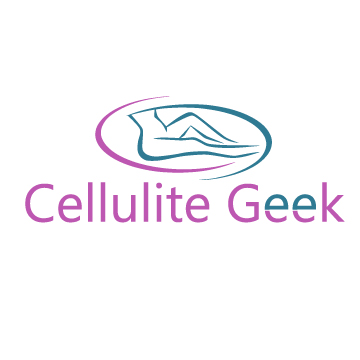Does Liposuction Get Rid of Cellulite?
Important Note From Author: spotted this unusual shortcut for getting rid of cellulite
Its all explained in this 3-Step Cellulite Removal Presentation
What Is Liposuction
Many of us know how difficult it is to achieve harmony with the way we look. Sometimes neither diet nor exercise will bring the desired effect and we turn to cosmetic procedures to get rid of unwanted fat. Studies show that 80%-90% of women develop cellulite in their lifetime. Liposuction can be one of the procedures that may come to mind to treat cellulite. The price of such a treatment can be high, but for the sake of finding our dream physique, many are ready to afford such an expense.
Liposuction is a cosmetic or bariatric surgery to remove fat deposits surgically. The operation is performed on a specific area (or several areas) of the body, for example, on the stomach, thighs, buttocks.
It may sound somewhat unpleasant, but liposuction is carried out safely by modern methods. It is a low-impact operation, which at the same time, gives a noticeable and lasting result. With the word “liposuction,” most people think of removing fat from the abdomen or buttocks only. However, this operation can be performed anywhere on the body.
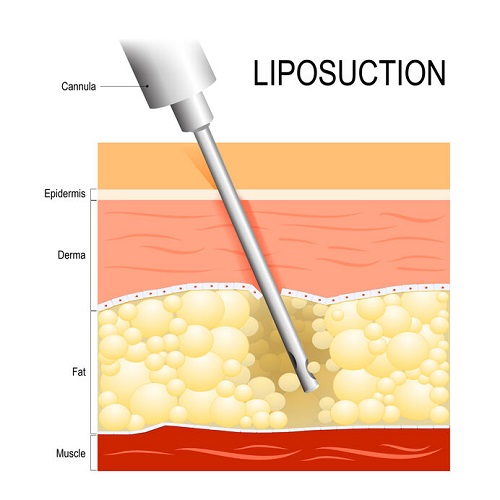
How Does Liposuction Work?
Liposuction is a cosmetic or bariatric surgery to remove fat deposits surgically. The operation is performed on a specific area (or several areas) of the body, for example, on the stomach, thighs, buttocks.
It may sound somewhat unpleasant, but liposuction is carried out safely by modern methods. It is a low-impact operation, which at the same time, gives a noticeable and lasting result. With the word “liposuction,” most people think of removing fat from the abdomen or buttocks only. However, this operation can be performed anywhere on the body.
But Does Liposuction Actually Get Rid of Cellulite?
Just like any treatment to reduce cellulite, liposuction does not permanently remove cellulite since it does not affect the biological mechanism leading to the condition, but more importantly since liposuction does not target the upper layers of the skin where cellulite resides it is not an effective treatment for treating cellulite. While liposuction is not an effective treatment for cellulite, this article will discuss what liposuction is and how it works.
How Does The Liposuction Procedure Work?
Standard liposuction procedure involves the insertion of small suction tubes called cannulas into very short incisions located close to fat deposits. The fat deposits are then suctioned out of the body using a syringe or surgical vacuum attached to the cannula.
After a period of swelling lessens the improved body contour becomes apparent. Ideal candidates for liposuction should be within 30% of their ideal weight, have good muscle tone, are non-smokers, and have elastic skin. Individuals should be without other life-threatening illnesses or medical conditions that may prevent the body from healing.
Cellulite News Update: stumbled upon this unusual technique for getting rid of cellulite
Click here to watch this 3-Step Cellulite Removal Presentation
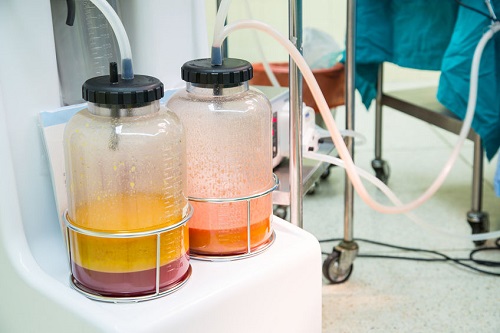
What Types of Liposuction Treatments Are There?
While liposuction is not an answer for weight loss or sagging skin, it can enhance the look of your skin and help you slim down those problem areas. For those considering liposuction there should be an optimistic outlook with specific aims in mind for body contouring. If liposuction is a procedure you are considering there are six distinct types of liposuction available:
Traditional Liposuction or Suction Assisted Liposuction (SAL)
Traditional liposuction is performed with fine cannulas that are manually inserted under the skin through small incisions of 2-3 millimeters. Excess fatty deposits are then suctioned out of the body. This procedure is performed under local or general anesthesia, depending on the area to be treated and the volume of fat to be extracted.
Tumescent Liposuction
Unlike traditional liposuction for the surgical removal of fat, the principle behind tumescent liposuction is based on the infiltration of the problem zone by injecting large volumes of a special lipolytic solution. The solution causes the targeted areas of fatty deposits to become tumescent, put differently, swollen and firm. The solution causes blood vessels to constrict reducing the likelihood of blood loss and hematomas resulting from injury to blood vessels, nerve fibers, connective tissue. This solution then turns the fat into an emulsion where it finally suctioned from the body. Bruising, swelling and pain which are common after liposuction surgery are also minimized. Tumescent liposuction came about in the 1980s. Tumescent liposuction quickly gained the trust of doctors and patients. The advanced technology made it possible to get rid of unwanted fatty tissue deposits without injuring the tissues and practically eliminated the chance of side effects.
Ultrasound-assisted Liposuction (UAL)
The Ultrasound-assisted liposuction technique, or ultrasonic liposuction, employs a cannula that will transmit ultrasound vibrations to break up and dislodge fat leaving blood vessels, fibrous tissue, and muscle intact. Once the fat has been liquefied it is then suctioned out of the body. The benefits of ultrasound-assisted liposuction are a minimization of trauma, bruising, and blood loss.
Laser-assisted Liposuction (LAL)
Laser liposuction, also known as laser lipolysis, is liposuction procedure that employs laser energy from fiber optic cables at differing wavelengths to heat and melt fatty deposits. The liquefied fat is then suctioned from the body from a thin cannula. One of the benefits of laser liposuction is that it stimulates collagen production allowing the skin to become firm and tight.
Power-assisted Liposuction (PAL)
With power-assisted liposuction the cosmetic surgeon uses the cannulas that are connected to an adapter which generates vibrations. These vibrations promote the dissolution of fat cells and reduce the amount of force required by the plastic surgeon to feed the cannulas. This allows him to work much more precisely and save tissue.
High Definition Liposuction (HDL)
Hi-Def liposuction allows patients to get a precise sculpting of a desired physique by removing fat from both large and delicate areas more accurately. It defines the abdominals or marks the pectorals. Excess fat can infiltrate those areas and the traditional liposuction method is not optimal for obtaining a desired shape. The procedure involves ultrasound to liquefy fatty deposits which are then suctioned out of the body. It produces better skin retraction for more athletic results, minimizes surgical trauma, and reduces blood loss.
Don’t forget to check out this popular method of getting rid of cellulite
Click here to watch this 3-Step Cellulite Removal Presentation
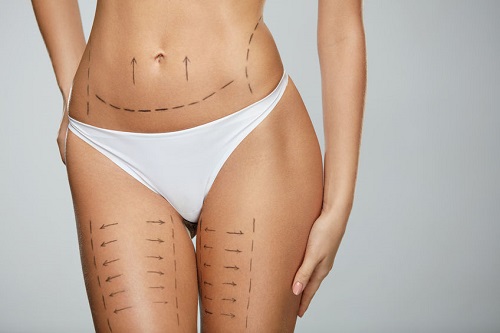
What Are The Most Common Areas for liposuction Surgery?
- Arms
- Back
- Chin
- Knees
- Thighs
- Legs
What You Should Know About Recovering From Liposuction Surgery
3-4 weeks are the ideal recovery time after liposuction surgery. During the first couple of weeks, just like other surgeries, the patient is not allowed to do heavy tasks. Initial Period The initial period of recovery is accompanied by swelling and pain, the appearance of hematomas and discomfort when touching the skin. Bruises and swelling can shift downward (to the legs, lower abdomen) by gravity.
Wear Appropriate Garments
During this period, it is necessary to choose the correct underwear that will shape and adjust the silhouette and tighten the skin. The surgeon can calculate the required size and help you choose one or several sets (as the body size will decrease, by the end of the rehabilitation period the original underwear can become large and stop performing its function).
Limit Sun Exposure
It is necessary to refrain from sun exposure during warmer seasons to reduce total time spent in the sun. You cannot visit the sauna and solarium, take a hot bath, and use hard washcloths and peeling agents.
Doctor Follow Up
If the patient is experiencing severe pain, then you should consult a doctor who can choose the appropriate anesthetic medication.
Limit Physical Exertion
It is necessary to refrain from physical exertion.
Antiseptic Use
The seams left after the insertion of the tubes should be treated with an antiseptic to avoid infection.
Next Stage of Liposuction Recovery
The next stage of recovery comes in one, rarely two weeks. At this point, hematomas and tumors should pass. The volume of the skin is reduced and will acquire a tone.
Supplement Healing
To speed up the healing process, it is recommended to take courses of therapeutic massage, phototherapy and other similar procedures.
Normal Sleep Garments
Corrective underwear can now be removed at night
Avoid Sun & Hot Baths
Sun, hot baths and the like should still be avoided
Final Stage of Liposuction Surgery
The final stage of normalization begins after three weeks or a month. At this time dead fat cells have become utilized, the skin becomes elastic, and the figure achieves its necessary outlines.
Daytime Garments
During this period, it is still necessary to wear corrective underwear
Regulate Diet
You should also regulate your diet to avoid re-gaining weight
Consider Lymphatic Drainage Massage
It is recommended to undergo a course of lymphatic drainage massage to speed up the recovery process
Take Care of Surgery Areas
After the operation, there are small seams that need to be taped or covered with clothing from the environment.
The final result will be visible six months after the procedure. However, in order to preserve the figure it is subsequently necessary to eat properly and use physical activity. The question of does liposuction work can be answered with a yes, but as you can see there are some post-treatment activities that are necessary if you want to maintain the surgery results.

Which Liposuction Surgery Should You Choose?
In short, it depends on the needs, budget, and the patient request. For example, if patient wants the results of liposuction show off his muscle texture, then HDL is the best choice. On the other hand, those who only want a reduction of localized fat, then traditional method should work just fine. Device manufacturers for each type of liposuction technique may also claim that each device has its own unique advantages, and cosmetic surgeons might determine to use one technique over another therefore it’s always good to have a consultation before you move forward with a liposuction procedure.
Is Liposuction Considered An Invasive Procedure?
Traditional liposuction is generally considered to be the most invasive due to the potential for tissue trauma, extensive bruising, and prolonged recovery time. Laser liposuction is an alternative to traditional liposuction and considered minimally invasive with shorter recovery times, but still the potential for bruising and tenderness in the treated area. Similar to laser liposuction, ultrasonic liposuction is a minimally invasive procedure that minimizes tissue trauma, bruising and recovery times. Power-assisted liposuction is also deemed minimally invasive utilizing a specialized cannula to only target unwanted fatty deposits and break apart fat cells before removal. Hi-Def liposuction is also a minimally invasive treatment.
Is Liposuction FDA Approved?
Medical procedures utilize a variety of medical devices, but only specific devices are cleared or FDA approved for liposuction. As with any medical procedure it is vital to do your own research and check with your doctor regarding any questions you have and to determine that the device being used is FDA approved.
Liposuction Costs
Often, the sites of plastic surgery clinics indicate the cost of liposuction in details. However, you need to remember that you will have to pay not only for the operation itself, but also for preparation for it. The postoperative period is also associated with some expenses. As a result, the price of liposuction may be higher than expected and noticeable. Therefore, it is important to immediately represent the level of costs and know what factors add up the cost of liposuction:
Consultation
Consultation with Doctor Sometimes clinics include consultation in the base cost of a liposuction operation, but most often they pay the initial admission separately, while postoperative consultations are usually free. And this is logical – the doctor is responsible for the result of his work. The price of the primary consultation of a plastic surgeon is about 40 USD.
Preliminary Exam
Analysis Doctors will not perform liposuction without first examining the patient’s test results. Before liposuction (no earlier than 2 weeks before the operation), it is necessary to pass a general and biochemical blood test, an infection test (hepatitis B and C, syphilis and HIV), a coagulogram, Rh and blood group, urinalysis, and ECG and provide the results of chest radiography of the organs of the chest (their “expiration date” is 1 year). In addition, it is necessary to obtain the opinion of a therapist, and in some cases, a cardiologist. The cost of all tests ranges from 100 – 300 USD depending on what laboratory you use and how quickly you want to get results.
Operation
Its cost depends on the area being treated, the surgeon’s qualifications, the level of the medical center and even the location of the clinic — liposuction in larger metropolitan areas can be more expensive than in rural areas. Generally, the traditional liposuction costs 2000 – 3500 USD
Anesthesia
As a rule, liposuction is performed under general anesthesia. A two-hour general anesthesia costs roughly 200 USD
Hospital Stay
In order to minimize the risks, the patient after liposuction is recommended to spend at least 1–2 days in the hospital. Depending on the level of the medical center and the comfort of the ward, the cost of one day in the hospital can vary from 50 – 70 USD/ per day.
Compression Underwear
After surgery, compression underwear should be worn for a proper healing. Sometimes, its cost is already included in the price of liposuction. If not, get ready to pay around 150 USD for a compression band. Its cost depends on both the manufacturer and the area where the surgery was performed.
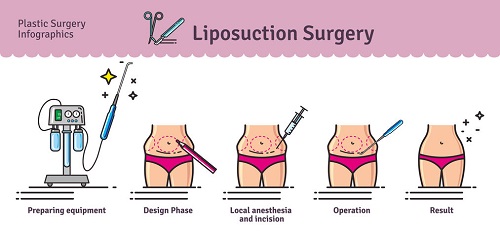
Risks or Side Effects
It does and you should be aware of any side effects and risks. There is a risk of unpleasant consequences, as with any other surgical intervention. It depends on many factors: starting with the skill of surgeons and ending with the peculiarities of the patient. Side effects include:
- Closure of blood vessels with blood clots or fat.
- Hematomas and edemas. Most dissolve in a few weeks or months.
- Inflammations
- Numbness in the area of liposuction, which lasts several months.
- Change in skin color in the area of operation.
- The effect of washboard. With uneven pumping of fat, bumps and irregularities are formed, so that the area of the body after liposuction resembles a washboard.
- In case of unsuccessful operation, adipose tissue is unevenly distributed and disproportions of the figure are visible.
I found this crazy shortcut for getting rid of cellulite
Click here to watch this 3-Step Cellulite Removal Presentation
